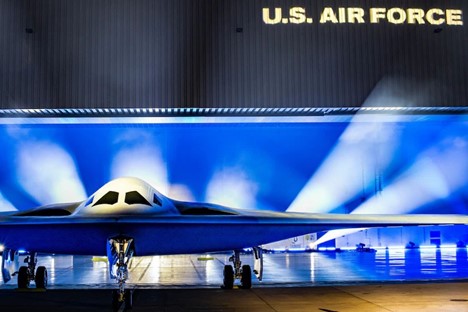After years spent hidden away, the next-generation aircraft of the U.S. Air Force’s long-range bomber fleet was unveiled to the public for the first time during a special ceremony late last year, marking a major milestone for the sixth generation of military aerospace.

The Northrop Grumman B-21 Raider, the Air Force’s new stealth bomber and the United States’ first new bomber in roughly three decades, was partially rolled out of a hangar at Air Force Plant 42 in Palmdale, CA under the cover of darkness on Dec. 3, 2022. It has an exterior like the B-2 Spirit – the Air Force’s current long-range stealth bomber - but the Department of Defense says this new aircraft will be unlike anything we’ve ever seen.
"Fifty years of advances in low-observable technology have gone into this aircraft," said Secretary of Defense Lloyd Austin at the unveiling. "Even the most sophisticated air-defense systems will struggle to detect a B-21 in the sky."
Developed to deliver conventional and nuclear weapons while remaining nearly invisible to radar, the B-21 Raider is slated to serve as the backbone of the Air Force’s bomber fleet once its development is finished this decade. It’s expected to eventually supplant B-1 Lancers and B-2s currently in service and serve alongside modified B-52 Stratofortresses – America’s workhorse heavy bomber since the 1950s.
The Air Force plans to purchase at least 100 Raiders, with the aircraft expected to make its first flight in 2023.

The B-21 is a highly-advanced aircraft that’s expected to provide the armed forces with an extensive advantage for decades. But how is still largely unknown because its finer details and capabilities remain highly secretive. Photographers at the exclusive unveiling on Dec. 3 were even compelled by base officials to photograph the new plane at a height no more and no less than six feet to avoid capturing curvatures, angles, and surfaces the Air Force does not want to be seen yet.
While details have mostly been kept under wraps so far, the world’s “first sixth-generation aircraft” is designed with open system architecture. It’s projected to be capable beyond its years and feature enough software and hardware flexibility to keep pace with evolving technologies over the next several decades.
The B-21 is most likely going to possess state-of-the-art avionics, stealth, and weapons systems that are firmly in the tier expected from sixth-generation aircraft. Constructing and operating these types of systems requires advanced interconnects capable of transferring significant amounts of data and power very quickly. And with the B-21 speculated to be capable of a 6,000-mile range and even more with mid-air refueling, any connectors used on this aircraft must be able to operate flawlessly under harsh circumstances in every aerospace environment on Earth.
Data will dominate sixth-generation military aerospace

While fifth-generation aircraft like the F-35 Joint Strike Fighter are still rolling off assembly lines, militaries around the world are beginning to look ahead to sixth-generation aircraft technology like the B-21 to stay ahead of the curve.
This technology isn’t fully defined yet. It’s still relatively conceptual, and whatever exists today is mostly classified. But there are several design features expected to be incorporated, including:
- Advanced sensors and avionics: These aircraft are expected to feature advanced sensors capable of gathering and processing vast amounts of data from their surrounding environment. Sophisticated avionics could enable flight and operational capabilities far beyond that of current technology and bolstered by the integration of AI.
- Network capabilities: Sixth-generation aircraft are expected to be able to smoothly integrate with other systems, such as air and ground platforms as well as satellites, to share data, coordinate operations, and provide command, control and communications (C3) functions.
- Advanced weapons systems: These aircraft are expected to feature advanced weapons systems that can engage a wide variety of targets with precision accuracy. This may feature both the incorporation of traditional munitions as well as new technology such as directed energy weapons.
While exact data requirements are unknown because the technology is still being researched and developed, these capabilities will require rugged and durable aerospace assemblies and interconnect systems capable of gathering, processing, and facilitating the rapid exchange of high-speed data between systems and subsystems within the aircraft such as sensor data, navigation data, and control signals. Amphenol R-VPX interconnects are an optimal interconnect solution for tackling these challenges.
There are several other theoretical ways R-VPX connectors could be utilized on sixth-generation aircraft, including but not limited to:
- Redundancy: Providing redundant data paths between subsystems to ensure continuity of operations in case of a primary system failure.
- Scalability: Providing scalable and modular architecture that allows for easy integration of new subsystems or upgrades to existing subsystems.
- Weight reduction: Reducing weight on the aircraft by providing a more compact and lightweight solution compared to traditional interconnects.
- Cybersecurity: Implementing cybersecurity measures to protect the aircraft's systems from cyber-attacks and ensure the integrity of the aircraft's data.
Amphenol R-VPX solutions

Amphenol Aerospace offers a variety of high-speed R-VPX interconnects ideal for addressing the design challenges posed by sixth-generation aircraft technology where data processing, speed, performance, and rugged durability are priorities. This includes Amphenol’s MIL-HD2, which can scale data rates to 56Gb/s PAM4.
The MIL-HD2 was developed in alignment with The Open Group Sensor Open Systems Architecture™ (SOSA™) technical standard and provides a ruggedized, open architecture solution capable of very high speeds for applications where space requirements and density come at a premium.
Configurations to meet SOSA/VITA 91 requirements for HD Switch.
- 4 diff, 8 column - SOSA aligned configuration.
- Data rates scalable to 56Gb/s PAM4 to support system upgrades without costly redesigns.
- Proprietary crosstalk-reducing technologies.
- 15.7mil drill-compliant pin allows deeper backdrilling.
- Optimized footprints.
- Shielded contacts mate before signal contacts, providing up to a 4mm minimum wipe.
- Embedded capacitor available.
- Differential pairs 28-84 per inch (11-33 differential pairs per centimeter).
- Highest density with 1.80mm pitch.
- Proven EMI and signal integrity advantages.
- Improved impedance matching.
- Complete solution for unique customer requirements.
- Enables hot plugging.
- Meets high-density application requirements.

Shown: 128 high speed differential pair in copper (56 Gbps PAM4)
plus 72 channels of fiber

Shown: 3U 1” VPX slot offering 160 differential
pairs with MIL-HD2

Outside the SOSA standard, Amphenol offers a suite of VPX connectors starting with our R-VPX (ruggedized VPX) Evolution connector, which offers data transfer speeds of 16+ Gbps and meets OpenVPX requirements. It also meets VITA 46 and 47 performance requirements and is intermateable with existing VITA 46 backplane connectors.
Our R-VPX Evolution 2.0 is even faster. With data speeds in excess of 25 Gbps, these are among the fastest VITA 46.30 connectors in the world.
R-VPX EVOLUTION 1.0:
- 16 Gb/s+ performance.
- 4-point contact system.
- Module connector has modified footprint - utilizes smaller compliant contacts for increased Si performance.
- Backplane connector is the legacy connector- no changes necessary on the backplane.
- Intermateable with existing/legacy VITA 46 connectors.
- Footprint compliant with 46.30 (VITA draft spec).
Supports High-Speed Protocols:
- PCIe Gen 4
- 1000BASE-KX
- 10GBASE-KX4
- 100GBASE-KR4
- Infiniband SDR, DDR, and QDR
- Serial RapidIO 12.5 Gbaud
R-VPX EVOLUTION 2.0:
- 25Gb/s+ performance.
- 4-point contact system.
- Module AND Backplane connectors utilize smaller compliant contacts for increased Si performance.
- Intermateable with existing/legacy VITA 46 connectors.
- 30 Spec compliant.
Supports High-Speed Protocols:
- PCIe Gen 4 and Gen 5
- 1000BASE-KX
- 10GBASE-KX4
- 100GBASE-KR4
- Infiniband SDR, DDR, and QDR
- Serial RapidIO 12.5 Gbaud and 25 Gbaud
For more information and to view our full line of VITA products, visit Amphenol Aerospace VITA High-Speed Connectors.